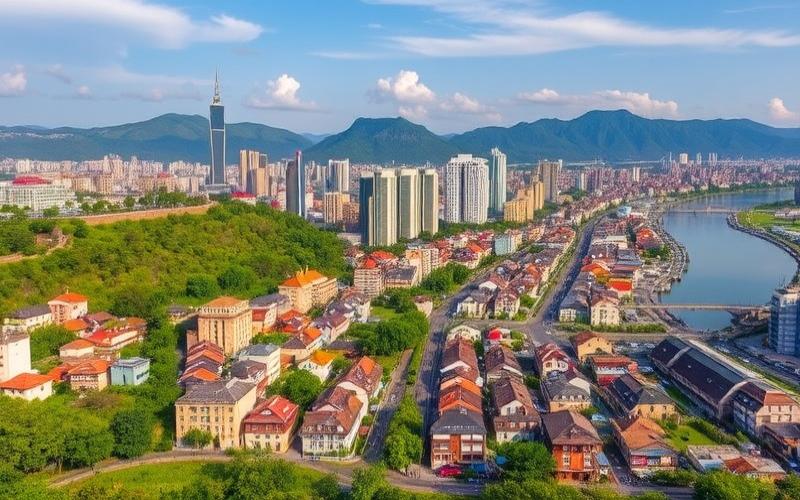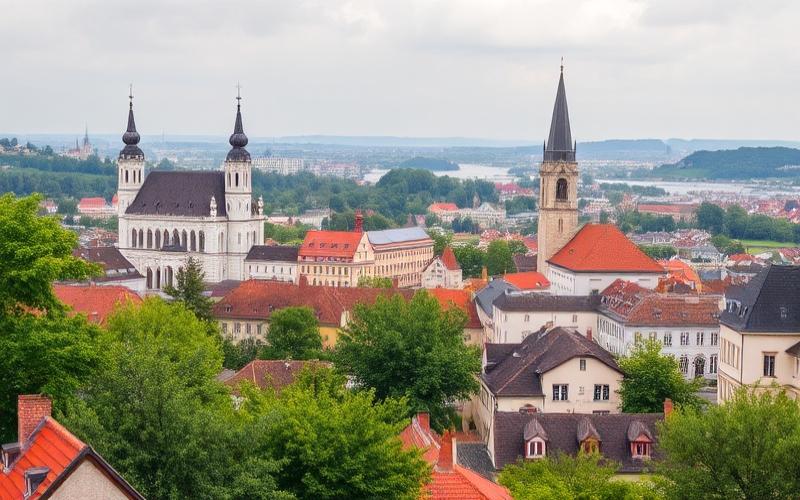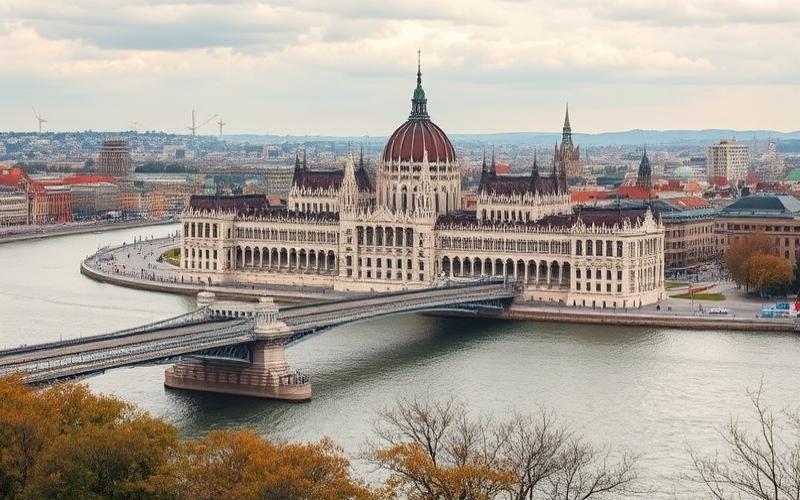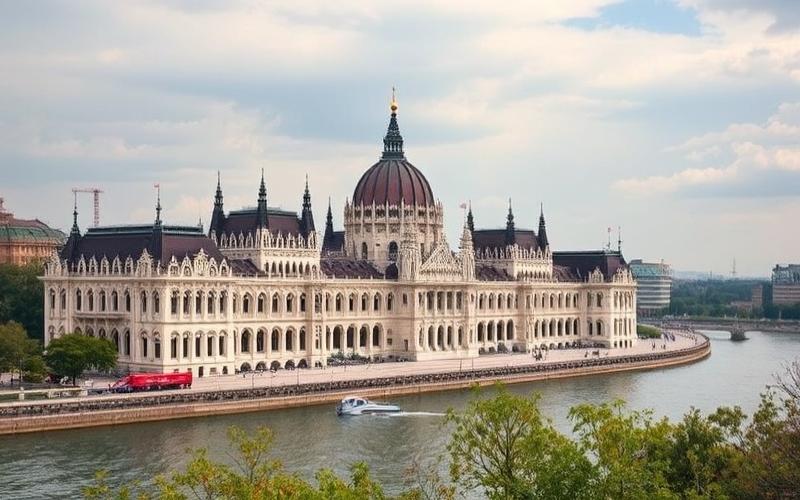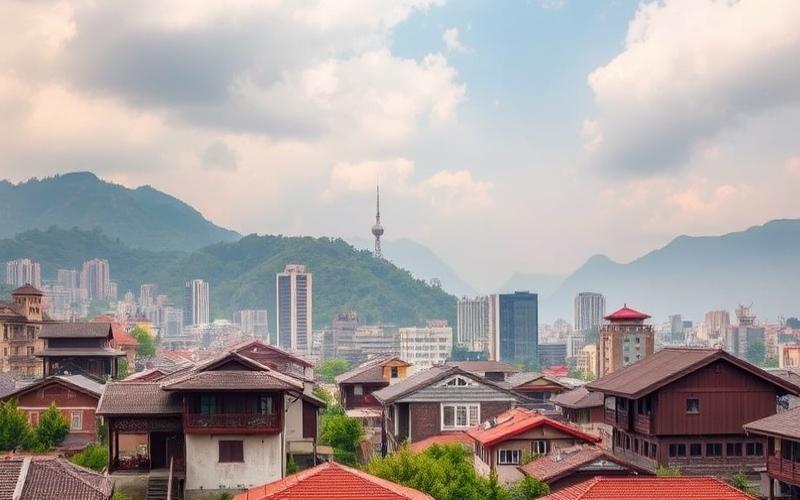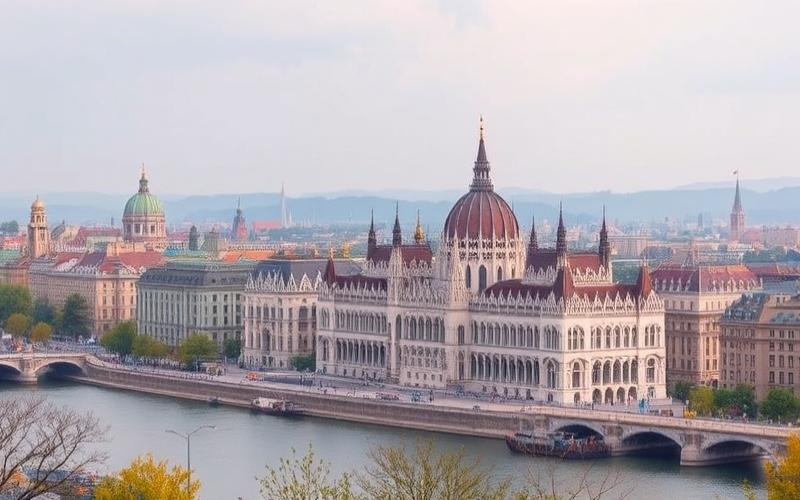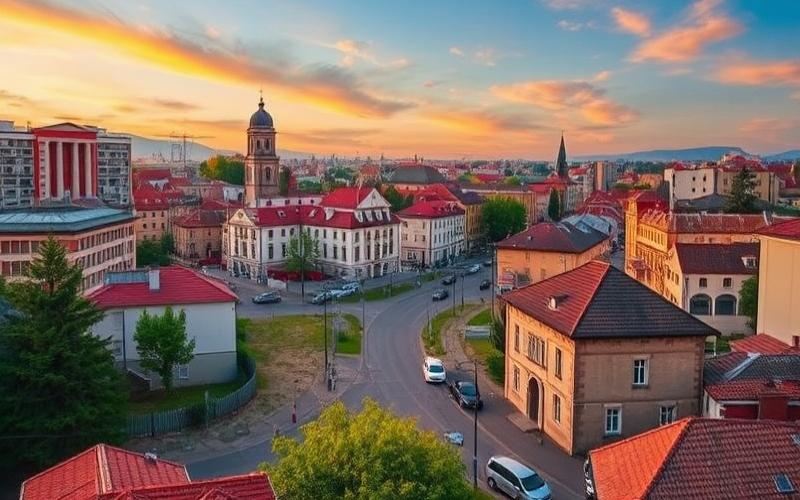
 Published on and written by Cyril Jarnias
Published on and written by Cyril Jarnias
Investing in Central European real estate can be an exciting adventure, but it’s crucial to understand the different market dynamics. Whether taking advantage of Hungary’s charming villages or exploring opportunities in Poland and Slovakia, each country offers distinct advantages.
This comparison provides an overview of Hungary’s economic and financial strengths in real estate investment compared to its neighboring countries, exploring local market trends, government regulations, and growth prospects.
Through this analysis, investors can better identify opportunities that will offer not only stable returns but also long-term appreciation.
Positioning Hungary against its neighbors in the real estate market
| Country | Average price per m² in city (2025) | Market dynamics | Average rental yield | Homeownership rate | Economic/political factors |
|---|---|---|---|---|---|
| Hungary | Approx. €3,000–3,500 (Budapest) | Recovery after stagnation, historical volatility | High (4–6%) | 91.6% | Investor-friendly policies, accessible credit, moderate interest rates |
| Austria | €5,000–8,000 (Vienna) | Moderate growth, stability | 3–4% | 54.5% | Mature market, stable credit access, strict regulation |
| Slovakia | €3,690 | Sustained growth, urban demand | 4–5% | ~90% | Rising interest rates, variable credit access |
| Romania | €2,500–3,000 | Rapid growth, strong demand | 5–6% | ~95% | Dynamic market, incentive policies, affordable credit |
| Croatia | €3,000–3,500 (Zagreb) | Strong coastal demand, urban stability | 4–5% | ~91% | Tourism influence, seasonal fluctuation, credit access |
| Serbia | €2,000–2,500 (Belgrade) | Rapid growth, emerging market | 5–7% | ~95% | Openness to investors policy, developing credit |
Significant differences:
- Prices in Budapest remain significantly lower than in Vienna, Austria’s capital, where the market is more mature and expensive.
- Hungary and Romania offer similar prices outside capitals, but Hungary’s institutional stability attracts more foreign investors.
- Slovakia shows prices close to Budapest’s, but with more regular growth.
- In Croatia, demand is highly localized on the coast, while Hungary mainly attracts to Budapest.
- Serbia remains the most affordable, but with a less secure market dynamic for foreign investors.
Market growth and dynamism:
- Hungary: After several years of stagnation, the market is rising again, particularly in Budapest, which is becoming attractive again thanks to competitive prices and high rental potential.
- Austria: Low but constant growth, stable market, low volatility.
- Slovakia & Romania: More marked growth, strong demand in major cities, particularly Bratislava and Bucharest.
- Croatia: Stability in Zagreb, rapid growth on the Adriatic coast linked to tourism.
- Serbia: Recent strong growth, but still young and sometimes risky market.
Economic and political factors:
- Interest rates: Lower in Hungary and Romania than in Austria, favoring credit accessibility.
- Government policies: Hungary offers favorable conditions for foreign investors, especially in Budapest; Austria imposes more restrictions and taxation.
- Credit accessibility: Easier access in Hungary, Romania, and Croatia than in Serbia, where the financial market is less mature.
- Political context: Hungary’s stability reassures investors, despite some concerns about judicial independence and regulatory predictability.
Foreign investor preferences:
- Budapest is the most sought-after area in Hungary, ahead of Lake Balaton (second homes and seasonal rentals).
- In Vienna, stability and prestige attract wealthy investors, but rental profitability is lower.
- Bratislava and Bucharest appeal through their economic dynamism and attractive yields.
- On the Croatian coast, foreign investors are very present for tourist rentals.
- Belgrade attracts a growing number of investors seeking low prices and high appreciation potential.
Key takeaways:
Hungarian real estate prices are significantly lower than Austria’s, close to Slovakia and Croatia’s, but remain very attractive given the market’s regained stability and dynamism, particularly in Budapest. Credit accessibility, favorable policies, and high rental yields explain foreign investors’ interest in Hungary, especially in the capital and major tourist areas.
Good to know:
In Hungary, real estate prices are generally more affordable than in neighboring countries, except for Romania and Serbia where they are comparable, while in Austria and Slovakia, prices are significantly higher. The Hungarian market is experiencing moderate growth, marked by government policies supporting homeownership, historically low interest rates, and increased mortgage accessibility, contributing to more stable demand compared to the growing functionality of the Croatian and Romanian markets. Foreign investors particularly favor Budapest and Lake Balaton for their strong appeal and investment return potential, whereas in countries like Croatia, the Adriatic coast remains highly popular. Additionally, political factors, such as Hungarian government stability, and an open economy facilitate transactions, unlike some foreign investment restrictions observed in Austria.
Price attractiveness in Hungary vs neighboring countries
Comparison of residential and commercial real estate prices (2025)
| Country | Capital / major city | Average residential price €/m² | Rural area €/m² | Commercial price €/m² (indicative) | Trend 2024-2025 |
|---|---|---|---|---|---|
| Hungary | Budapest | 2,900 – 5,000 | 1,000 – 1,500 | 2,000 – 4,000 | +4 to +8% |
| Debrecen, Győr, Szeged | 1,900 – 2,200 | 900 – 1,300 | 10%), they weigh on local demand, but remain attractive for foreign investors with external financing. |
Market dynamics: After explosive growth (prices multiplied by 2.5 in Budapest since 2015), the increase is slowing (around +4% in 2024), especially for new builds and central properties.
Real estate policies and specific factors in Hungary
- Reduced VAT on new builds: 5% on new housing (vs 27% standard), incentive measure renewed until 2026.
- State subsidies: “CSOK” (purchase assistance for families), tax credit for first-time buyers, support for energy renovation.
- Taxation: No national property tax, but low local taxes; degressive capital gains tax after 5 years.
- Tourist rental control: Increased regulation in Budapest on Airbnb-type rentals to limit speculation.
Investment prospects and market expectations
- Residential: Strong interest from expatriates and European investors for Budapest (appreciation, high rental demand). In provinces, the market is supported by local demand, but liquidity remains lower.
- Commercial: Growth in logistics and office segments, industrial sector dynamism (particularly in Győr, Székesfehérvár).
- Buyer segments:
- Foreign investors: Seeking yield, tax arbitrage, diversification.
- Locals: Sensitive to credit rates, preference for homeownership.
- Hungarian diaspora: Purchasing pied-à-terre or family properties in provinces.
Legal and cultural specifics affecting attractiveness
- Foreign ownership: Possible for EU nationals without restrictions, administrative procedures simplified since 2023.
- Less transparent market: Importance of local network, strong variation depending on property quality and location.
- Homeownership culture: Very high ownership rate (91%), low institutional rental market outside Budapest.
- Political stability and legal framework: Legal security for investment, well-protected property regime.
Hungary maintains strong attractiveness thanks to competitive prices, tax incentives, and stable rental demand, but selectivity and local knowledge become essential to maximize investment potential in an evolving market.
Good to know:
Real estate prices in Hungary are often more attractive than in neighboring countries, with a significantly lower average cost per square meter, especially visible in Budapest compared to Vienna or Bratislava. In 2023, the average price per square meter in Budapest was about €2,500, compared to nearly €4,800 in Vienna. Hungarian rural areas offer even more opportunities, with prices well below those observed in Czech or Austrian countryside. Hungary’s subsidy policy for first-time buyers and more favorable taxation partly explain this gap. Additionally, controlled inflation and competitive mortgage interest rates make investment attractive. However, buyers must consider Hungarian legal specifics, such as purchase restrictions for non-residents. The Hungarian market presents good profitability prospects, particularly for commercial real estate benefiting from growing demand in this sector.
Hungarian real estate taxation compared to neighboring countries
The tax environment plays a central role in international real estate purchase decisions. An advantageous tax regime can significantly improve investment profitability, while heavy or complex charges can divert investors to other markets. Costs related to property purchase, ownership, and sale therefore directly influence a country’s attractiveness.
Overview of real estate taxation in Hungary:
| Tax | Rate / Main method | Specificity |
|---|---|---|
| Rental income tax | 15% | Deductions for most expenses, including some travel costs |
| Capital gains tax | 15% | Full exemption after 5 years of ownership |
| Property tax | Variable, decided by municipalities (moderate) | Generally calculated per m², not on property value |
| Residence tax | None | |
| Acquisition fees | Registration: 4%; Lawyer: 1.5%; New build VAT: 5% | |
| Property advance tax | €5.6/m² |
Key takeaway: the absence of residence tax and low property taxes reduce ownership costs. Taxation on income and capital gains remains flat and attractive, especially with full exemption on capital gains after 5 years.
Comparison with neighboring countries:
| Country | Rental income tax | Capital gains tax | Property tax | Residence tax | Main remarks |
|---|---|---|---|---|---|
| Hungary | 15% | 15% (0% after 5 years) | Low, local | None | Broad deductions, flat taxation |
| Austria | 25% (after allowance) | 30% | Variable, sometimes high | Exists | Progressive system, heavier charges |
| Slovakia | 19% | 19% | Low to moderate | Sometimes, depending on municipality | Simple regime, fewer exemptions |
| Romania | 10% (after allowance) | 10% (after allowance) | Low | Sometimes, depending on municipality | Low charges, but fewer deductions |
Recent statistics (2023) on average taxation:
| Country | Average annual tax burden on rental investment (for €100,000 property) | Average net rental yield |
|---|---|---|
| Hungary | 4–5% of purchase price (acquisition); 15% on income, 0% on capital gains after 5 years | Up to 8% |
| Austria | 8–10% of purchase price (acquisition); 25% on income | 3–5% |
| Slovakia | 5–7% of purchase price (acquisition); 19% on income | 4–6% |
| Romania | 3–4% of purchase price (acquisition); 10% on income | 5–7% |
Impact on real estate market:
– Profitability: Hungary offers higher net profitability thanks to low taxation and attractive prices, especially in Budapest where market growth reached 31% since 2015.
– Regional development: Low taxes favor investment in secondary cities, stimulating development outside the capital.
– Advantages for investors:
- Fewer local charges.
- Possibility to deduct most actual expenses.
- Full exemption on capital gains after 5 years, allowing very advantageous medium-term strategies.
– Potential disadvantages:
- Variability of property taxes by municipality.
- As the market is very attractive, competition is increasing, particularly in Budapest.
Important highlight:
Tax optimization in Hungary relies on:
- Holding the property at least 5 years to benefit from full capital gains exemption.
- Systematic declaration and deduction of actual expenses to lower taxable base.
- Choosing areas with low local taxation (outside Budapest center).
Best practices for optimizing real estate taxation in Hungary:
- Prioritize long-term holding to benefit from capital gains exemption.
- Maintain detailed accounting of expenses to maximize rental income deductions.
- Research local taxation before purchase, as property taxes vary by municipality.
- Regularly compare effective taxation with neighboring countries to adapt wealth strategy.
- Consult a local tax expert to avoid declaration errors and benefit from bilateral tax treaties (especially for non-residents).
Hungary thus stands out with simple, transparent, and low-cost real estate taxation, offering a favorable framework for rental investment, especially compared to its more taxed and administratively complex neighbors.
Good to know:
Real estate taxation is crucial for investors, significantly influencing their decision when purchasing in a specific country. In Hungary, capital gains tax is 15%, while property tax varies by municipality, often well below rates in Austria and Slovakia, which can reach 30% and 20% respectively. In Romania, capital gains tax is 3% for residents. According to 2023 data, the average tax level for an investor in Hungary is about 6% of the sale price compared to 12% in Austria and 8% in Slovakia. These tax differences can make the Hungarian market more attractive for long-term projects, even if sometimes less developed than its neighbors’. A potential investor can benefit from Hungary’s relatively low tax charges to optimize profitability, with expert recommendations suggesting proper wealth structuring to maximize tax advantages under these diverse regimes.
Disclaimer: The information provided on this website is for informational purposes only and does not constitute financial, legal, or professional advice. We encourage you to consult qualified experts before making any investment, real estate, or expatriation decisions. Although we strive to maintain up-to-date and accurate information, we do not guarantee the completeness, accuracy, or timeliness of the proposed content. As investment and expatriation involve risks, we disclaim any liability for potential losses or damages arising from the use of this site. Your use of this site confirms your acceptance of these terms and your understanding of the associated risks.










